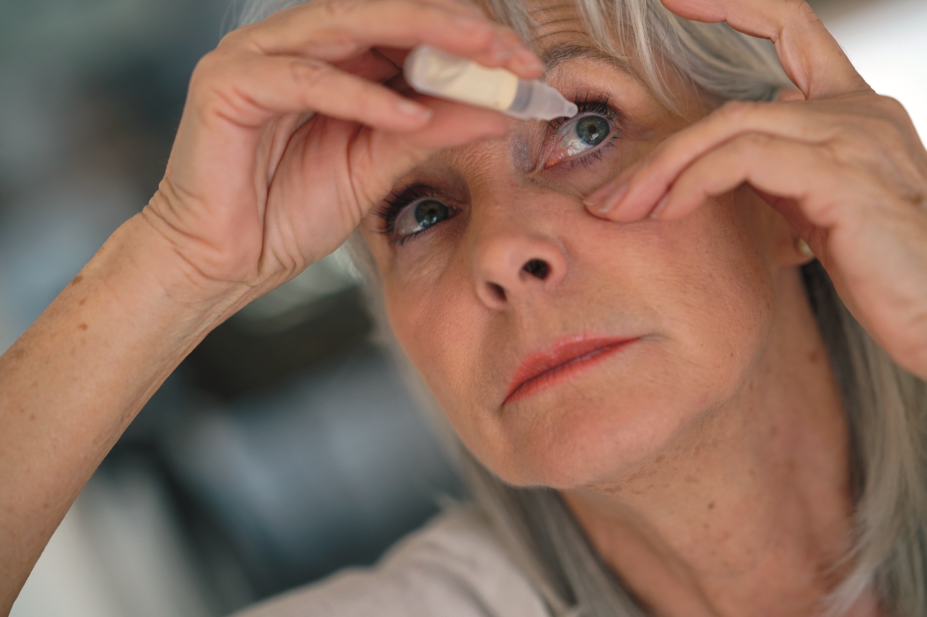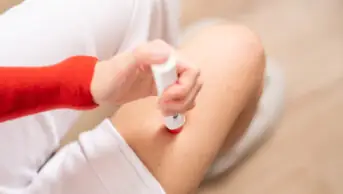
Shutterstock.com
Patients who are susceptible to dry eye disease may seek advice from pharmacy technicians to try to prevent or reduce their symptoms.
- Advise patients to avoid air blowing in their eyes. For example, suggest that they avoid the use of hair dryers and do not sit directly under air conditioning or fans;
- Suggest that patients use an air humidifier. This will help to moisten the air, which can help to reduce the risk of eyes drying out;
- Recommend that patients consider wearing wrap-around sunglasses or other protective eyewear. Safety shields can be added to the tops and sides of eyeglasses to block wind and dry air;
- Advise patients to take regular breaks during long tasks that require visual concentration. This can include looking away from the computer screen, for example, or remembering to blink regularly;
- Suggest that patients who use a computer to position it correctly. The user should be looking down at the computer screen, so that they do not have to open their eyes as wide. This will help to prevent evaporation between blinks;
- Recommend that patients who smoke stop smoking and avoid smoky environments. Smoke can trigger symptoms of dry eye disease, and can cause or exacerbate other health problems. Many pharmacies offer a smoking cessation service to support patients;
- Advise patients to avoid eye make-up, particularly eyeliner or mascara. These products can block meibomian glands and cause inflammation around the eyes, exacerbating symptoms;
- Suggest increasing the amount of omega-3 in the patient’s diet, or omega-3 supplements. There is evidence to suggest that omega-3 can be helpful in preventing symptoms of dry eye. Omega-3 is present in fish and fish oils, canola oil, flaxseeds and walnuts. Several formulations of omega-3 supplement, specifically for dry eye, are also now commercially available. The supplements may be particularly useful for patients with blepharitis or patients who have dry eye caused by contact lens wear;
- Recommend an over-the-counter treatment if appropriate. There are many different types of over-the-counter treatments available in a variety of different formulations.
Example: Providing lifestyle advice for a patient with dry eye disease
A patient enters the pharmacy and approaches you at the medicines counter with a bottle of eye drops from the shop floor.
Pharmacy technician: Good morning, what can I do for you today?
Patient: I have recently been diagnosed with dry eye disease by my optician. I wear glasses, and Dr. Chowdhary recommended these drops for me. I just wondered if there was anything else I could do to help?
Pharmacy technician: Yes, I can definitely give you some help with that. Firstly, I can see you are wearing eye makeup. It might be helpful to avoid using eye makeup, at least until your symptoms go away. Also, blowing air into your eyes can make the symptoms worse, so try to avoid using a hairdryer. Do you use a computer at all?
Patient: Yes, I use one all day for work. I’m a receptionist.
Pharmacy technician: Ok, so it is definitely important to ensure your computer is positioned correctly. The screen should be lower than your eye line, to help ensure your eyes aren’t opened unnecessarily wide.
Patient: Ok, fantastic, thank you.
Pharmacy technician: If you are still having problems, please do come back in. If your symptoms get worse, it would be best to make another appointment with your optician. They may be able to recommend some wrap-around prescription glasses, to help protect your eyes. Would you like me to scan those drops for you now?
Patient: That would be great, thank you.
Over-the-counter treatments
In 2015, the most commonly prescribed artificial tear in England was hypromellose. Hydroxypropyl methylcellulose (HPMC), more commonly known as hypromellose, is cheap and readily available both in preserved and non-preserved formulations[1]
. However, to gain adequate relief, it may be necessary to administer this treatment very frequently (for example, hourly), so more viscous products are often required.
Prescribed treatments, which include artificial tears and lubricants, were dispensed at a cost of more than £27m to the NHS in England alone in 2014[2]
. There are a wide variety of over-the-counter treatments, which can help patients with mild dry eye disease. Over-the-counter treatments for dry eye disease are available in several different formulations including drops, gels, creams, ointments and sprays. Some of these formulations are known as ‘artificial tears’.
Carbomer 980 binds moisture to the ocular surface, increasing the time for which moisture is retained. This is useful for overnight use or where extended protection is required during the day.
- Advise patients not to drive if their vision is impaired by blurring caused by gels, ointments or creams. Some formulations can cause blurred vision on application, so suggest that patients test a new product before they have to drive. The blurring will usually clear after a few minutes;
- Advise patients that carbomer-based gels tend to cause less blurring than ointments. The carbomer viscosity decreases when in contact with the eye;
- If blurred vision is a problem for patients, suggest they try a different formulation. There are many different formulations available, including drops, gels, creams, ointments and sprays.
Another artificial tear ingredient is carmellose.
Carboxymethylcellulose is often used if hypromellose or carbomer 980 does not give adequate relief.
If the dry eye disease is more severe or if symptoms are persistent (chronic), it may be necessary to use a lubricant with viscosity increasing properties, such as sodium hyaluronate. Sodium hyaluronate remains on the surface of the eye longer than other artificial tears, such as hypromellose. Studies have shown that sodium hyaluronate relieves symptoms more effectively than other formulations, such as hypromellose, carbomer or carboxymethylcellulose, particularly in more severe dry eye cases. If dry eye disease is severe or chronic, it can lead to pain, ulcers or scarring on the cornea. In some rare cases, it can lead to loss of vision.
Hydroxypropyl guar (HP-guar) products increase in viscosity in contact with the surface of the eye, forming a gel. This mimics the mucous layer of the tear film. These products may be beneficial in both types of dry eye disease, with specific product choice depending on severity. Eye inserts, which contain hydroxypropyl cellulose, may be prescribed. These are applied to the eyes in a similar way to contact lenses, and are inserted up to twice a day.
Higher viscosity products are often required in severe dry eye or where treatments need to remain in the eye for longer, for example, for patients who cannot administer treatment on a regular basis because of physical difficulty or those with jobs that do not permit constant application of drops. Paraffin is the most common ointment, mixed with either wool fat, vitamin A, mineral oil or lanolin. These products are also useful for all patients for overnight wear.
If a patient presents at the pharmacy for the first time with severe dry eye disease, or presents repeatedly with symptoms that do not improve with the use of over-the-counter formulations, refer them to an eyecare specialist. If dry eye disease is severe or chronic, it can lead to pain, ulcers or scarring on the cornea. In some rare cases, it can lead to loss of vision.
Recommend that patients use ointments before bed. These products can cause blurred vision, so overnight use is recommended. They can also be useful for patients who do not fully close their eyes when they sleep, because tears can evaporate in this way, leading to symptoms of dry eye in the morning.
References
[1] Health and Social Care information centre. Prescription cost analysis – 2015. Available at: www.hscic.gov.uk/catalogue/PUB20200/pres-cost-anal-eng-2015-rep.pdf (accessed December 2017)
[2] Drugs and Therapeutics Bulletin. The management of dry eye. The BMJ 2016;353:i2333. doi: 10.1136/bmj.i2333



